1st-Ever Sharrow Prop Test on Yamaha 425 XTOs: 2.8 MPH Faster at WOT!
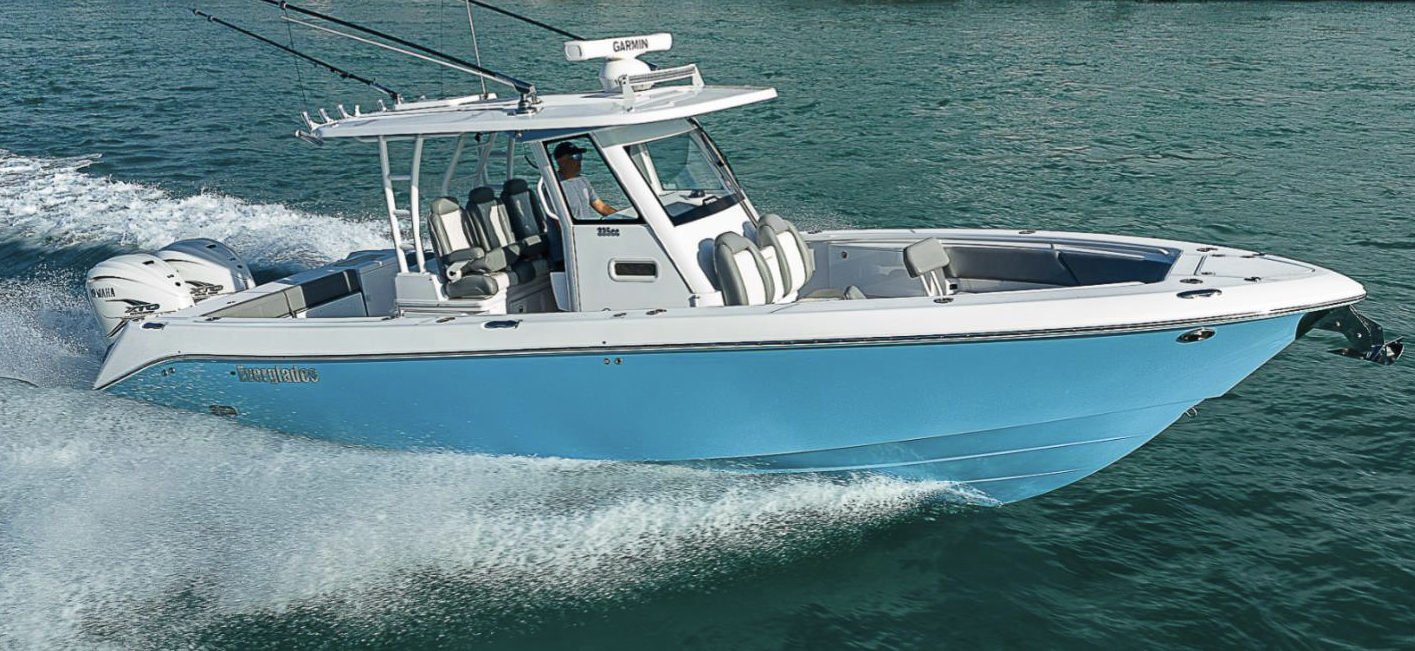
“When you don’t know what’s possible, why should you be dissatisfied with a boat’s performance?” boat owner Sean Riordan told us about his Everglades 335 with 2x Yamaha OTX 425s. “I’d never heard of Sharrow props until a friend of mine who owns a superyacht told me they could probably improve my boat’s performance. So, I decided to order a pair,” he said. They were tested last week for the first time – here’s the breaking news.
Last Thursday, March 16th, Sharrow props were put on a pair of Yamaha 425-hp XTO outboard engines powering an Everglades 335 center console. Comparison testing was conducted by Sharrow’s Director of Global Product Marketing Strategies, Karl Sandstrom, and the boat owner, Sean Riordan, a man who has been in the electronics end of the boat business for over 30 years, and a life-long boater.
Riordan owns “Ask the Advisors,” a consulting firm specializing in audio, video and security solutions for home or yacht, including superyachts. From what he told us about his business, this veteran boater is pretty busy, often in the Netherlands, the home of the superyacht.
BoatTEST did not conduct the comparison test of the Sharrow and standard props, and the numbers published below are from Sharrow Engineering. Their testing protocol is essentially the same as BoatTEST’s, but just as a double check, Capt. Steve and the BoatTEST crew will be testing this boat, engine and prop combination in several weeks in the same location. Keep an eye out for the video.

A Life on the Water
Sean Riordan grew up as a child on Mason Island, which is at the mouth of the Mystic River, and is one of the best-kept secrets in the Northeast. He started out as a young boy sailing a Herreshoff sloop on Long Island and Fisher’s Island sounds.
Sailing is probably the best way to learn how to be a good seaman of any type of vessel. He spent his early years sailing and working in electronics stores just when the field began opening up with new innovations.
Sean got into the boating business by out-fitting a superyacht and he never looked back. He naturally gravitated to the dark side where most of our readers are these days. And, since his cliental are mostly owners of megayachts and superyachts, the dark side can be pretty bright.
The Boat – An Everglades 335 CC

He told us that before he acquired the Everglades 335 he inspected and made sea trials on a number of the best brands on the market. Riordan said that he has a 25-point check list that he would put each boat through, including timing how long it took to drain the cockpit. This is, indeed, and important criteria for any open bow boat, and for some reason most people never think of it.
One of the things he liked most about the boat was its high-density foam inside and the fact that it would float level if swamped. The molded foam blocks put into the boat are one of the reasons it’s so expensive – and relatively heavy.
At the end of his search, Riordan selected the Everglades 355 CC. And, he liked the boat so much that he bought a second one on behalf of a client. (Shown above.)
Specifications of the Test Boat
The Everglades 335 has an LOA w/o engines of 32’4,” beam of 10’8” and a tested weight with two people aboard of approximately 17,000 lb. (9.85 x 3.25 m, 7,699 kg.). The boat was retrofitted for a Seakeeper and two conventional Rolls batteries, which Riordan said added at least 800 lb. (363 kg.) to the weight of the vessel. For that reason, our test boat is one of the heaviest 335s in the field.
The engines had 200 hours on them, and both Riordan and Sandstrom checked the standard props to make sure there was no damage, no dings.
Top Speed w/Standard Props
The top speed (WOT) recorded with the 335 using conventional Yamaha 16.6” x 19” x 3 ss props was 45.22 mph at 5400 RPM. Given the weight of the boat, that is a respectable speed, and Riordan had always been happy with it. But that was about to change.
After all of the speed runs were completed on reciprocal courses with the standard props, the boat was brought back to the marina, the fuel tank was filled once again, and the Sharrow 16.4” x 19” x 3 ss props were put on the boat.
Note that the diameter of the Sharrow props had a diameter .2” – less than 1/8th of an inch – shorter than the standard prop. According to Sharrow, that minute difference, would give the boat a slightly faster hole shot, and higher top end.
“A Different Boat” w/Sharrow Props
“It was amazing. I noticed the difference immediately when moving out of the marina at idle,” said Riordan, “there was no vibration…no rumbling like there normally is.”
“Once we got outside the boat felt completely different.” he said. “There was no vibration, and when sitting back at the transom the slapping of the water and the general noise was a much less.”
The WOT speed of the 335 with the Sharrow props was 47.98 mph at 5300 RPM, or 2.76 mph faster than the 45.22 mph produced at WOT by the standard props. That is a remarkable 6.1% increase in top speed.
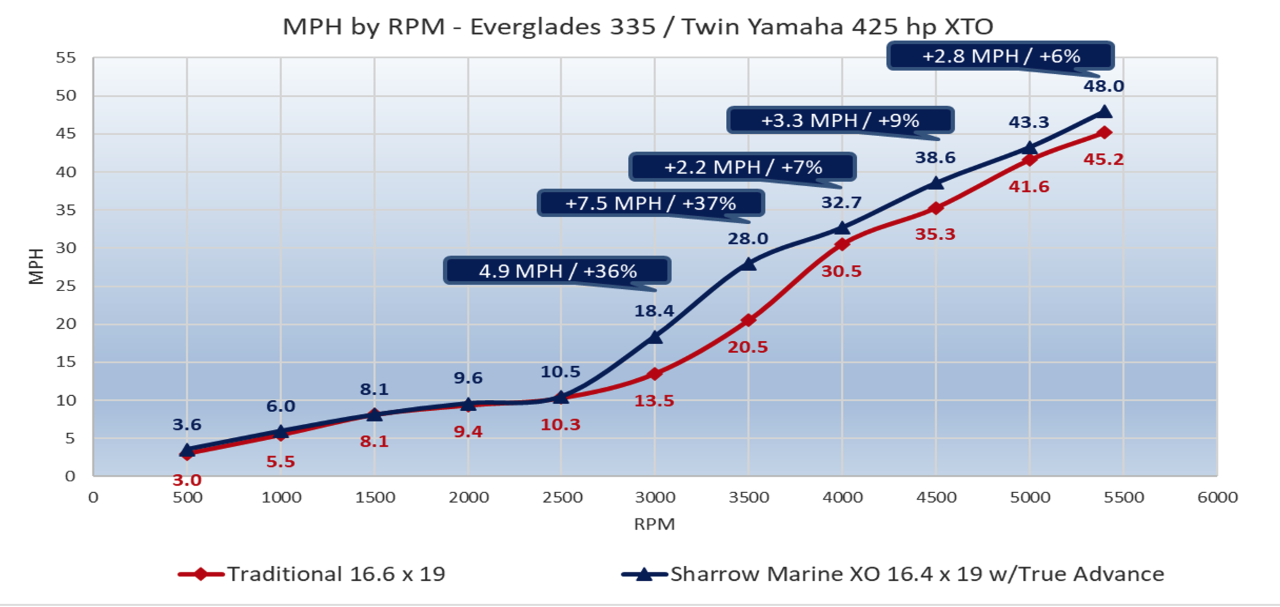
Faster Across the Board
Another important discovery in this test was that the Sharrow props went faster than the standard props at every RPM setting except one – and there it was a tie. As can be seen in the chart above, at 2500 RPM both props produced the same speed.
On Plane at 3000 RPM. Just after 2500 RPM the Sharrow prop almost immediately broke away, hitting 18.4 at 3000 RPM and going solidly on plane. At the same RPM, the 335 with standard props was still struggling to get over its bow wave, which would not happen for another 500 RPM.
This 36% improvement in speed is probably the most important speed differential on the chart, in our opinion. A boat that can get on plane at 3000 RPM, when slowing down from higher speed will stay on plane at a lower RPM because it doesn’t have to build up extra thrust to get over the hump.
“The Sharrow Sweet Spot”
Regular readers of BoatTEST are familiar by now with what we call the “Sharrow Sweet Spot.” That’s between 3000 and 4000 RPM – and on some boats as low as 2500 and as high as 4500 RPM.
Boats propped with Sharrow props typically get on plane 500 to 1000 RPM sooner, and have significantly better fuel consumption numbers in the “sweet spot” range. In this case, going 37% faster at 3500 RPM and 7% faster at 4000 RPM.
Note that 4000 RPM, the Sharrow prop was from 4% to 9% faster at every point until WOT where it was 6%, or nearly 2.8 mph faster.
According to Greg Sharrow - like Babe Ruth pointing his bat to the fences -- his engineers had predicted their design would be from 2.5 to 3 mph faster on the top end. These engineers are from the aerospace industry, one from NASA, and Greg is proud of their ability to predict from CAD modeling and simulations the performance of his props before empirical testing.
Fuel Consumption Comparison
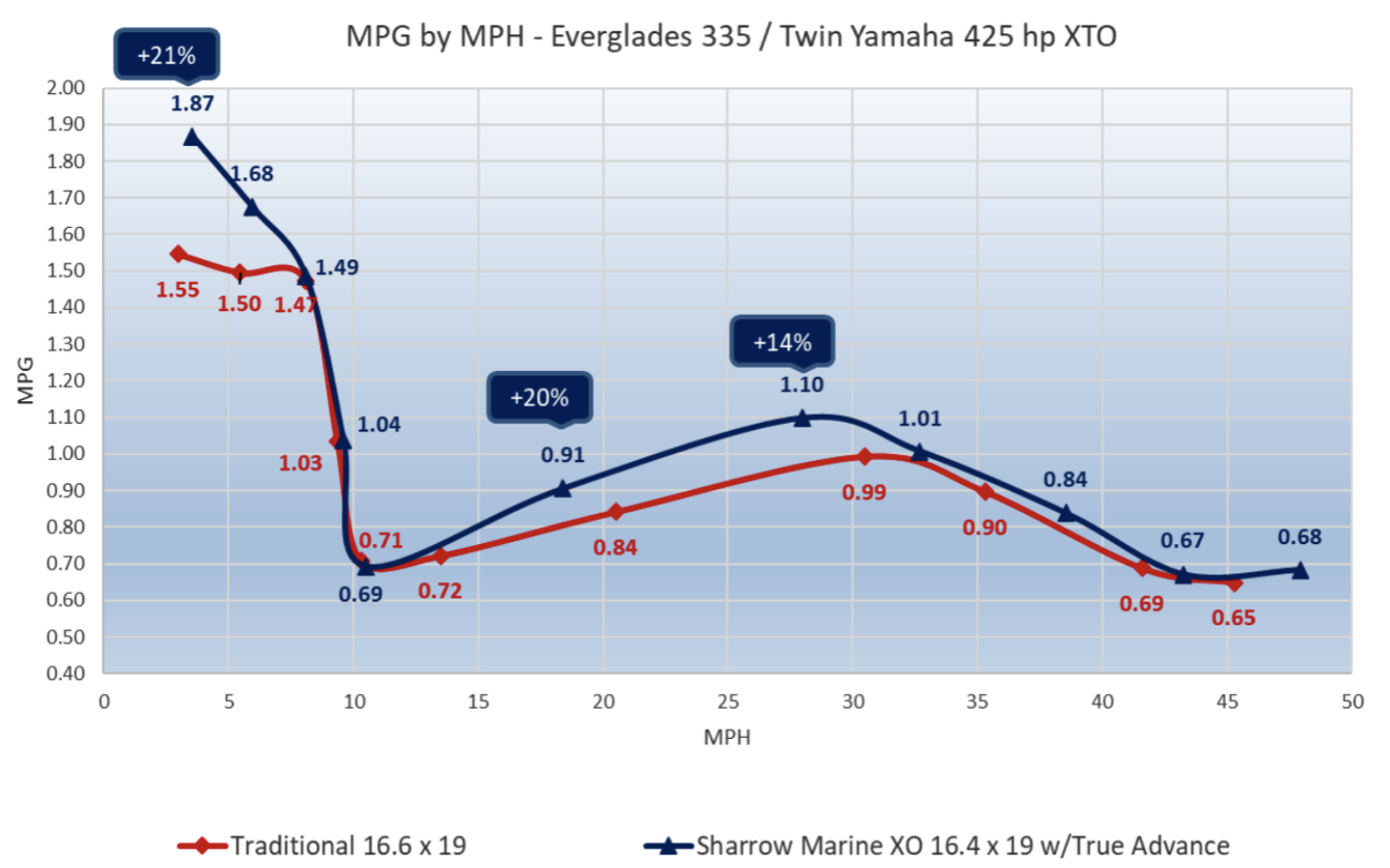
As can be seen above, the Sharrow prop is more fuel efficient at every RPM setting. The most important are, of course, where the boat is typically operated. Idle is another place where fuel consumption is important because ICOMIA, the international boating federation, says that 40% of any engine’s running time is at idle.
Magic? Note that the boat not only ran faster with the Sharrow props at WOT, but also burned 5% fewer gallons per hour than the standard props at their top-end speed. It is highly unusual for a boat to be nearly 3 miles per hour faster – and burn less fuel at the same time – than a competitive prop.
When company founder and CEO Greg Sharrow was asked how his props could be both faster and more fuel efficient at WOT, he said, tongue-in-cheek, “That’s the magic of the Sharrow prop!”
The “Magic” Explained
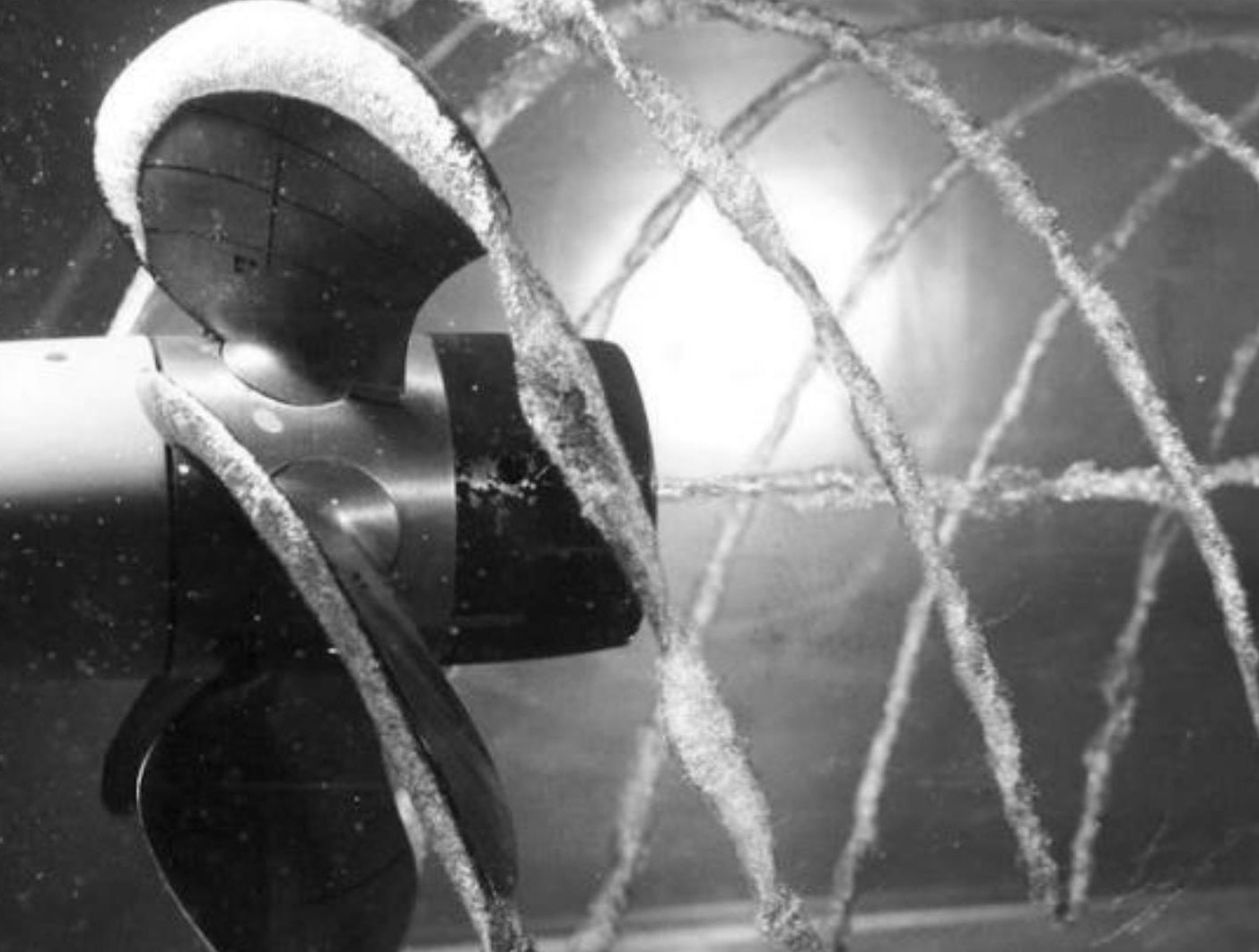
Of course, in world of fluid dynamics there’s no such thing as magic – but there is something called a breakthrough.
Breakthroughs in fluid dynamics have led to a range of technological advancements in fields such as aerospace, oceanography, meteorology, and materials science. Examples of breakthroughs in fluid dynamics include the development of turbulence theory, the invention of computational fluid dynamics (CFD) techniques, and the understanding of the physics behind vortices.
This is basis for Greg Sharrow’s “breakthrough” in propeller design.
One breakthroughs in fluid dynamics is credited to Richard Whitcomb, an aerospace engineer at NASA, who in 1976 conducted wind tunnel tests on models of aircraft with and without winglets. He found that winglets reduced drag by up to 6%, leading to significant fuel savings.
They also reduced noise and increased the plane’s range. Since then, winglets have become a common feature on most commercial aircraft.
Does this sound familiar?
In October, 2019, BoatTEST reported on its first test of a Sharrow prop and explained the fluid dynamics behind the design. See the Video/Read the report…
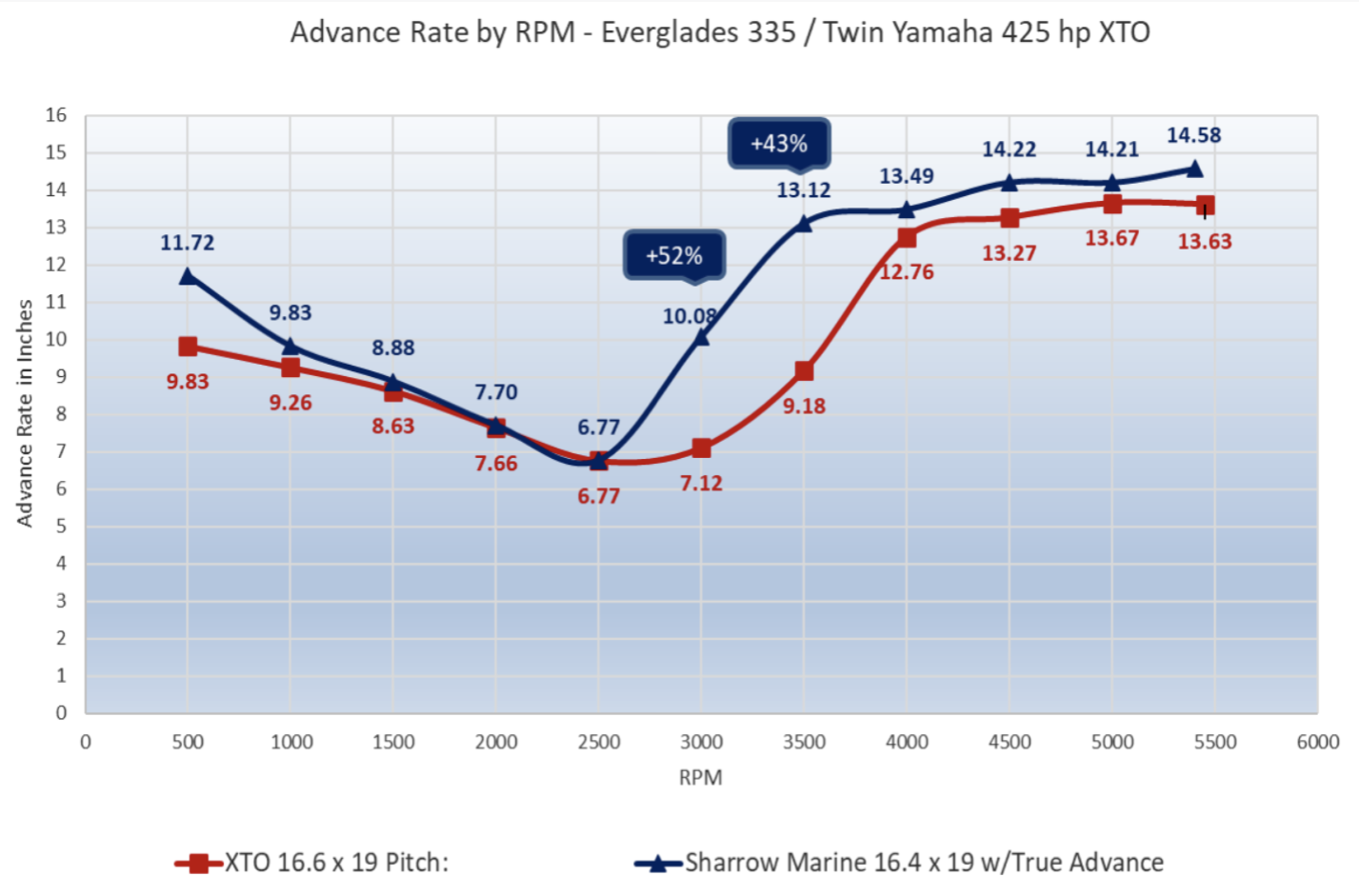
True Advanced
Theoretically, a propeller with a 19” pitch would advance 19” with every 360-degree revolution through a solid block of Jell-O. But in reality, props don’t advance as far as their pitch in water. The difference is called “prop slip” – and all props have it, even Sharrow props. But Sharrow props come closer to the theoretical advance as any prop we’ve seen. That’s why the company calls their design “True Advance™.
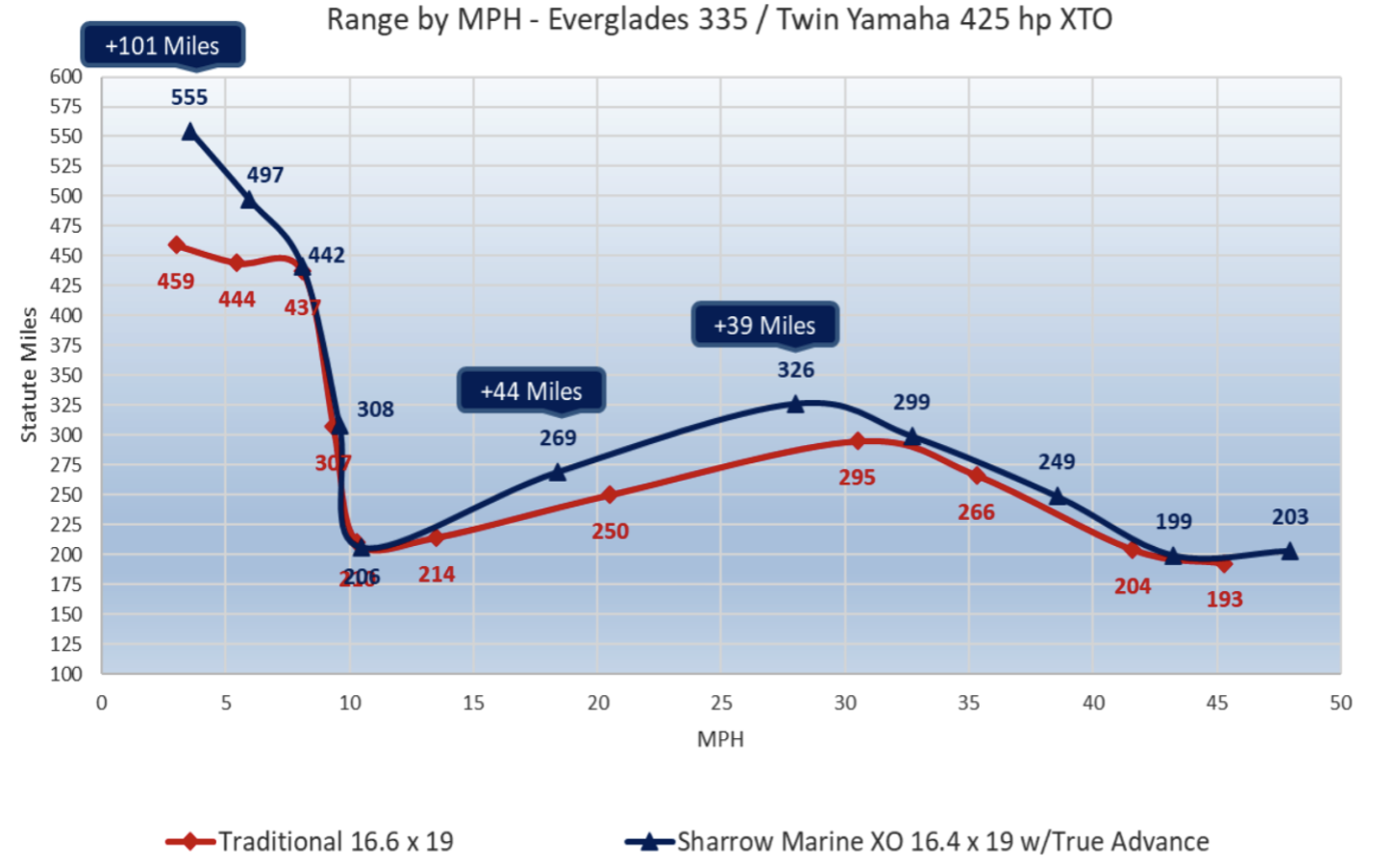
In the chart above we see how a greater advance by the propeller with every revolution simply moves the boat farther forward at virtually every RPM. The difference is most dramatic between 20 and 30 mph. When trying to maximize range, it is here will the boat will be operated. In snotty conditions, when the boat can’t safely be run faster, these are the speeds at which the Everglades 335 will likely be run.
But the coup de grace for the standard props in this application was at the top end. Here, the boat went 10 statute miles farther, and did it faster than the standard-issue OTX prop.
Sharrow is calling this new prop designed specifically for the Yamaha 425 OTX, the Sharrow “XO.”
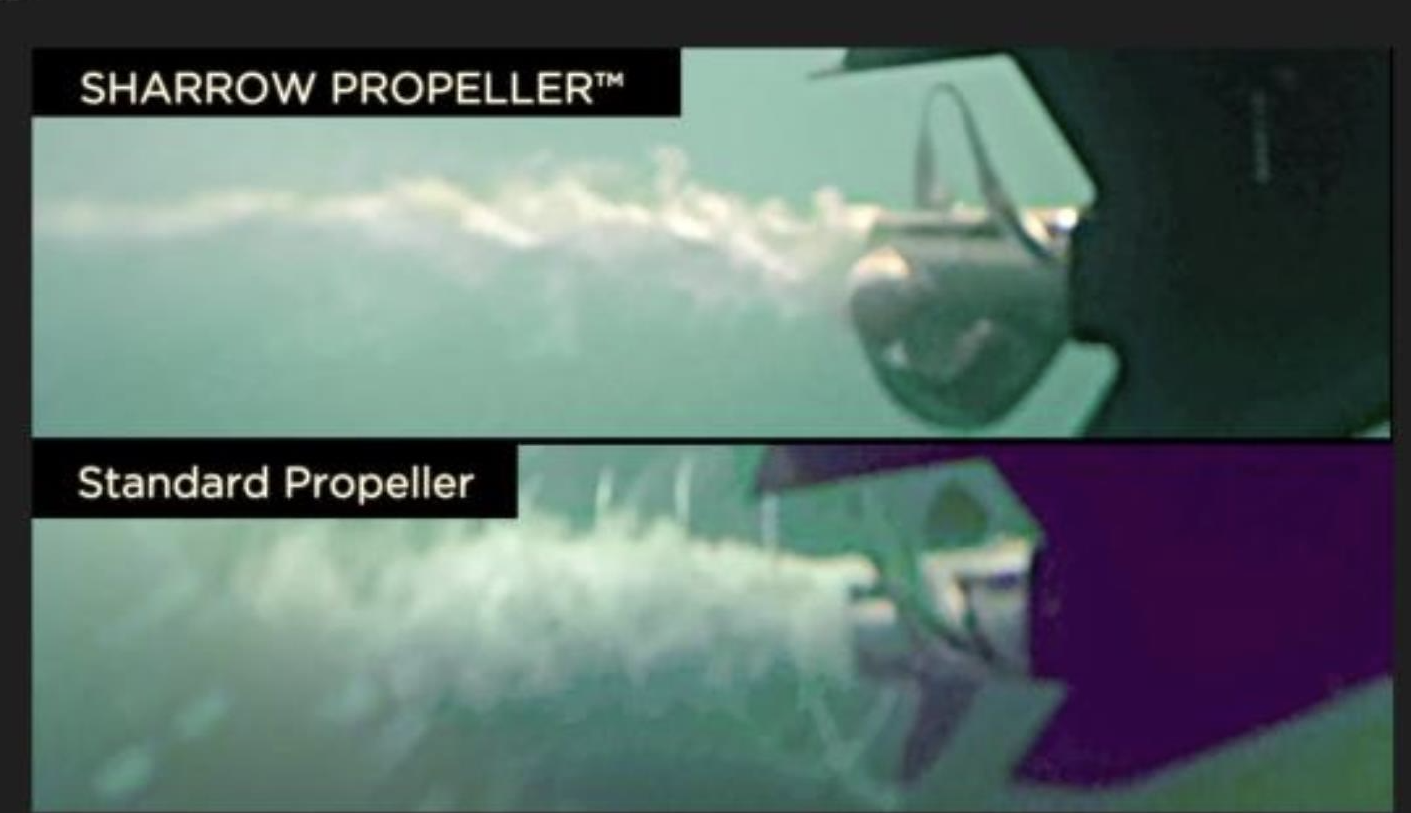
When Will Sharrow Props for the XTO Be Available?
Owners of XTO outboards have been asking for a couple of years when Sharrow would introduce a prop specifically designed for the XTO.
The answer to that question is: now, with a $100 deposit. There is a 120-day lead time for the new Sharrow XO prop.